What you need to know
The Windsor-Essex County Health Unit reminds its residents that if you are drinking water from a private well on your property, you can test your well water for free!
Year-round well water testing is free of charge for private residential use. Water is tested for total coliform and E. coli bacteria.
- Coliforms. These bacteria are often found in animal waste, sewage, soil and vegetation. If they are in your drinking water, it means surface water may be entering your well.
- E. coli (Escherichia coli). These bacteria are normally found only in the digestive systems of people and animals. If they are in your drinking water, it usually means that animal or human waste is entering your well from a nearby source.
On this page
- When and why should I test my well water?
- How do I get a sample bottle?
- How do I collect and submit a water sample?
- What do my results mean?
- Types of Wells
- Maintaining wells
- How do I disinfect my well?
- Types of water treatment systems
- Cisterns (water storage tanks)
When and why should I test my well water?
Well water quality can change and it’s a good idea to test your water at least 3 times per year to check for bacteria that could be harmful. It’s also recommended to test your well water after any repairs, heavy rains, flooding, long periods of non-use, or if there is any change in the amount of well water, smell, colour, clarity, or taste.
How do I get a sample bottle?
Special bottles must be used for collecting water samples.
These bottles can be picked-up and dropped-off for FREE at either of the following health unit office locations:
- Windsor: 1005 Ouellette Avenue, Windsor, N9A 4J8
- Leamington: 33 Princess Street, Leamington, N8H 5C5
Bottle pick-up times: Monday to Friday 8:30 a.m. to 4:30 p.m.
Bottle drop-off times: Monday to Thursday 8:30 a.m. to 4:30 p.m., Friday* 8:30 a.m. to 12:00.
*No Friday drop-off before holiday weekends.
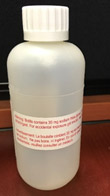
How do I collect and submit a water sample?
Public Health Ontario now offers a convenient and quick online portal for submitting water samples, in addition to the existing submission and reporting process.
Alternatively, if you prefer to collect and submit your samples using the traditional method, please visit the PHO webpage for step-by-step instructions.
What do my results mean?
| Total Coliform per 100 mL | E. Coli per 100 mL | What does this mean? |
|---|---|---|
| 0 | 0 |
Safe for drinking Maintain regular testing |
| 1-5 | 0 |
Safe for drinking Maintain regular testing |
| 6->80 | 0 |
Unsafe for drinking unless boiled or treated |
| 1->80 | 1->60 |
Unsafe for drinking unless boiled or treated |
| Overgrown (O/G) |
Unsafe for drinking unless boiled or treated |
If you receive an adverse water sample result, your drinking water is unsafe to drink. It is important that you:
- Stop using your well water
- Contact the Environmental Health Department at 519-258-2146 ext 4475 for more information
- Resample
Consider using commercially bottled water or municipal supply if available.
If you want to continue to use your well water, please see the treatment options listed below:
- Boil water at a rolling boil for at least one minute. (A rolling boil is a vigorous boil that cannot be stopped by stirring the water.) Note: Although boiling is adequate in eliminating bacterial contamination, it may actually concentrate other types of chemical contamination e.g. nitrate, or other metals and minerals.
OR - Mix 1.25 mL (1/4 teaspoon) of liquid household bleach to 4.5 L (1 gallon) of water. Let stand for 30 minutes. There should be a faint chlorine smell to the water. Use fresh, unscented chlorine containing 5.25 per cent sodium hypochlorite.
Refrigerate boiled or treated water in clean, food-grade containers.
Bottled or sterilized water is safe for drinking. It’s recommended to use for food washing and preparation (unless water will be boiled as noted above), brushing teeth, bathing children, and washing dishes.
Untreated well water can be used with caution for baths, showers, and laundry. You must disinfect your hands afterwards.
Types of wells
Homeowner’s should know what type well they have because its design, construction and maintenance have a direct effect on the quality and quantity of water you draw from it.
Drilled Wells: (Small-diameter casing of 10-20 cm (4-8in.)
- Casing is typically made of steel.
- If they are properly built, sealed, and maintained, they are at the least risk for contamination.
Large-Diameter Wells (Dug or Bored): (Large-diameter casing of 60-120 cm (24-48 in.)
- Large-diameter wells are generally more at risk to contamination and shortages during dry periods than drilled wells.
- Casing is usually made of concrete, or older wells may be made of brick, stone, wood, or corrugated steel.
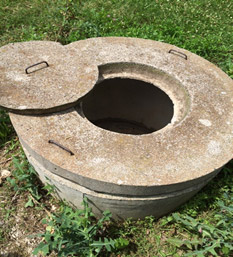
Well (or Sand) Points: (small-diameter casing of 2.5 – 5 cm (1-2in.)
- A small-diameter casing located in a shallow, sandy area
- Higher risk for near-surface contamination, and shortages during dry periods.
Maintaining wells
A properly maintained well helps prevent your water from being contaminated.
- Regularly check your well pump and distribution system
- Ensure the ground around your well casing slopes away from the well – there should not be ponding of water around the well.
- Do not store any chemicals near your well, including gasoline.
- Do not garden around the well casing and remove any plants.
- Make sure your well cap is securely sealed with no cracks or entry points.
- Inspect your well once a year, in the early spring.
- Look and listen for signs of surface water running freely into the well.
- Look for seepages through cracks or strains below joints on the inside of the well casing.
How do I disinfect my well?
A well may need to be disinfected if it is newly installed, or it has been serviced.
For more information, Public Health Ontario has published a technical bulletin and created a well disinfection tool. There is also a Best Management Practices: Water Wells document. A free copy can be picked up at any of our health unit offices or the municipal office on Pelee Island.
Types of water treatment systems
There are two main ways to treat your water supply: disinfection and filtration.
Disinfection is a process that uses a chemical or physical disinfection process such as chlorine, ultraviolet (UV) light or ozone. The most common methods to treat water systems is chlorine and UV light.
Filtration uses a filter to remove things like dirt and sand, and to reduce parasites from the water. A filter is required for all surface water systems and for groundwater systems that are at risk for surface water contamination. Examples of filtration systems are carbon and charcoal filters, reverse osmosis, and water softeners.
Cholorinators
These devices continuously add a certain amount of a chlorinated product for a certain period of time to allow for the water drawn through the system to be treated.
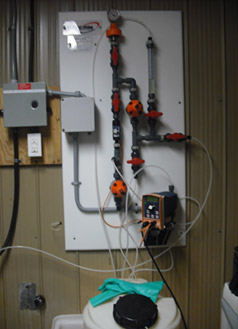
Ultraviolet (UV) Light
This process passes water by UV radiation. The special light is inside the water in a waterproof sleeve and sends out UV waves that can destroy harmful micro-organisms.
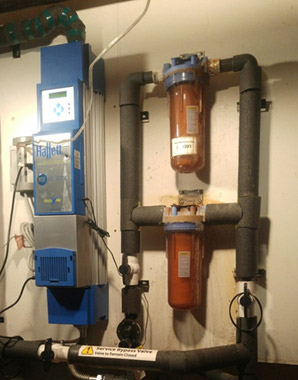
Reminder: always follow the manufacturers instructions for the use of any treatment systems.
*The quality and source of your well water will determine what type of treatment system if any is required to ensure your drinking water is safe to use.
| Contaminant | Possible removal technologies |
|---|---|
| Turbidity (suspended material, dirt) | Filtration |
| Fecal coliform (coliform, E. coli) | Disinfection |
| Viruses (Enteroviruses) | Filtration and Disinfection |
| Parasites (Cryptosporidium oocysts, Giardia cysts) | Filtration and Disinfection |
| Chemicals (Arsenic, Fluoride, Lead, Nitrate and Nitrite, Sodium, Uranium, etc.) | Contact a water treatment specialist to determine which device would be most suitable for your system: Submicron Filtration, Anion Ion Exchange, Activated Alumina, Reverse Osmosis, Micro-filtration |
Source: Ministry of Health and Long-Term Care, Small Drinking Water Systems: Treatment Options.
For more information on well water treatment, visit the Government of Canada’s webpage: Be Well Aware – Information for private well owners.
Cisterns (Water Storage Tanks)
Cisterns are tanks used for the storage of drinking water. These can be found above or below ground, and come in different shapes and sizes. Cisterns are common in areas where there is no access to safe drinking water or where water quality is poor. Water used in cisterns for drinking must come from your local municipal water treatment plant and be safe for drinking.
If you have a cistern on your property, it’s important to maintain it and test the water at least once per year to make sure it is safe to drink.
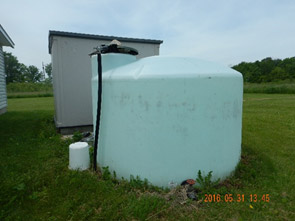
How do I maintain my cistern?
- All equipment that is in contact with drinking water needs to be in clean and sanitary condition.
- The cistern should be cleaned and disinfected by someone who is trained and who has the proper equipment.
How often do I need to sample the drinking water in my cistern?
- Cistern water should be tested at least once per year or after any cleaning and/or repairs. Water samples can be submitted to the health unit for free testing.
References:
- Ministry of the Environment and Climate Change (2018). Wells on your property.
- Ministry of Health and Long-Term Care (2009). Small drinking water systems under the health protection and promotion act treatment options.
- Ministry of Health and Long-Term Care (n.d.) “Small drinking water systems: Treatment options. Working together to safeguard our health”

